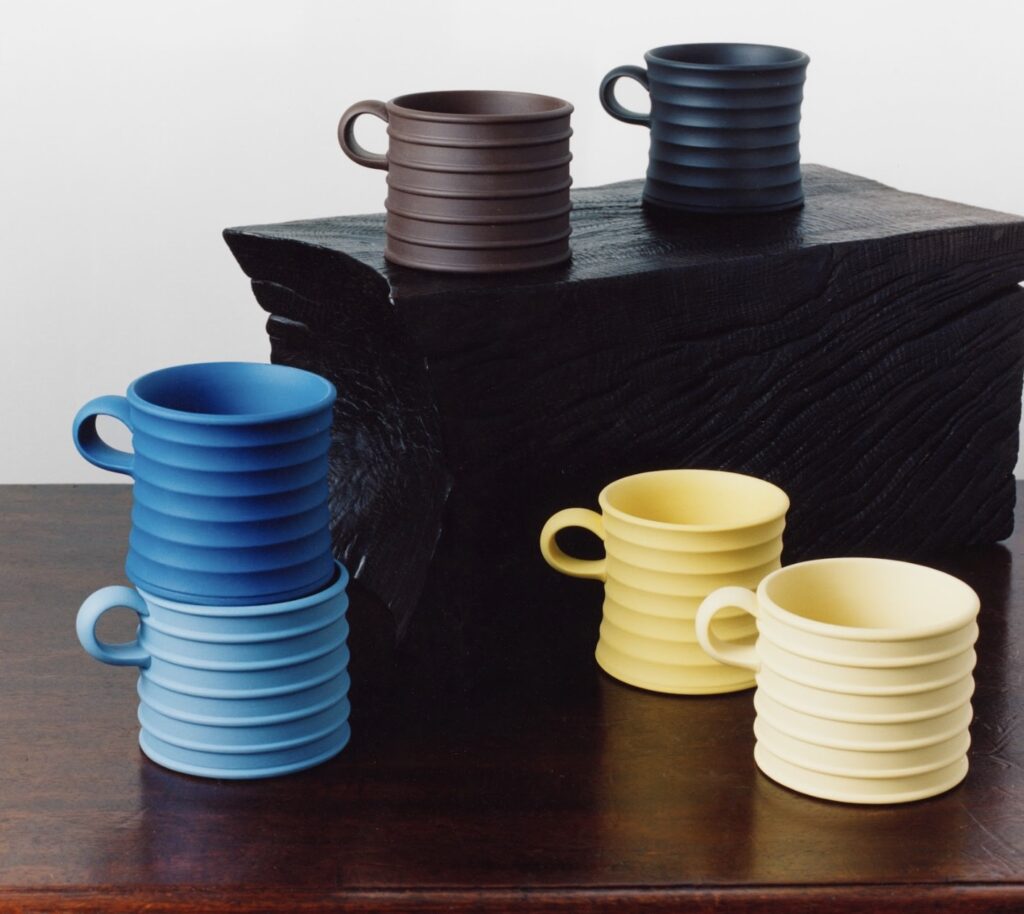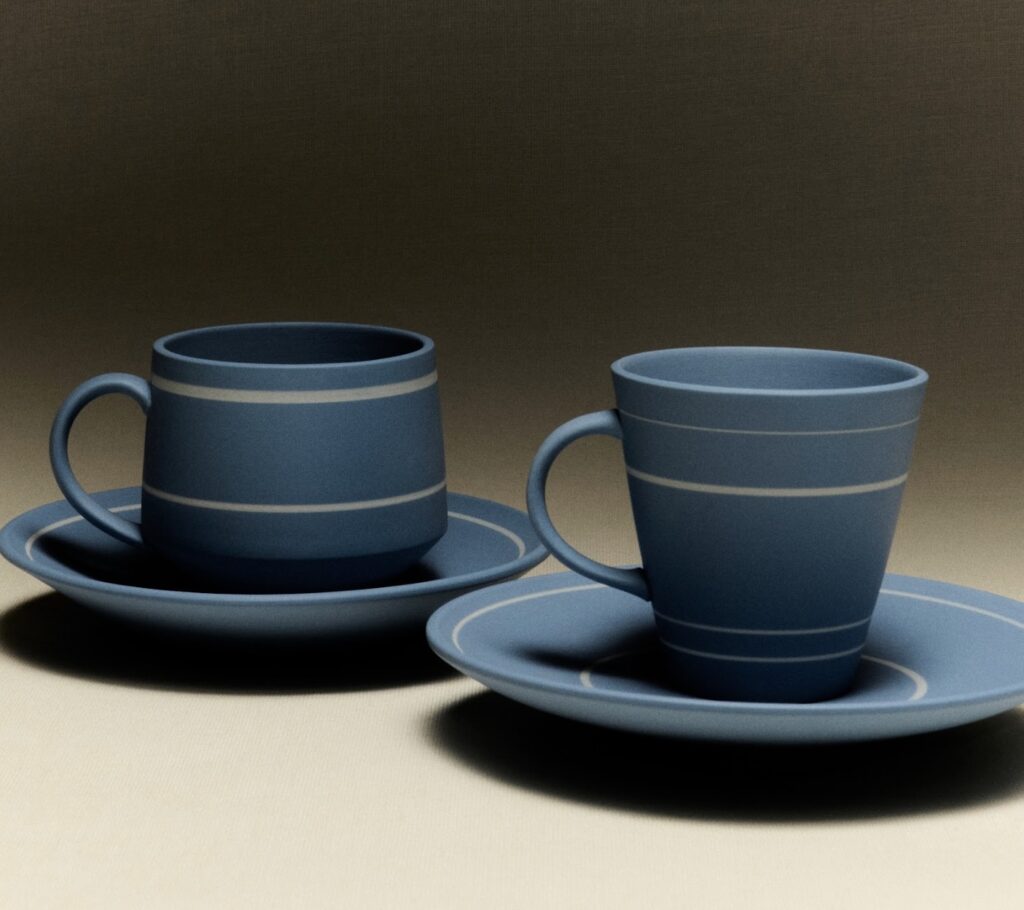Some collabs are fleeting commercial gestures; others are acts of cultural restoration. The latest partnership between JW Anderson, Wedgwood, and the estate of Lucie Rie belongs firmly in the latter category. What is being revived here is not just a set of ceramics but an idea frozen in time—Lucie Rie’s unrealized 1964 designs for Wedgwood, finally brought into existence over sixty years later. At once fashion, heritage, and art history, the project underscores the way design can transcend decades, remaining as vital today as when it was first sketched.
Lucie Rie: A Radical in Clay
Born in Vienna in 1902, Lucie Rie fled to Britain in 1938 as the Nazi regime rose in Austria. Her career in London positioned her as one of the most influential potters of the twentieth century. Rie rejected the rustic heaviness of the Bernard Leach school and instead cultivated a modernist language—sleek, precise forms enlivened by daring textures and glazes.
Her “sgraffito” technique—incising linear patterns into the surface of unfired clay, often under a contrasting slip—remains her signature. The results were not merely decorative but deeply architectural, offering a sense of rhythm and balance akin to textile design or modernist painting. She approached pottery not as craft in service of utility but as a dialogue between sculpture and design.
By the early 1960s, Rie had already exhibited internationally and influenced an entire generation of makers. That Wedgwood, the historic British ceramics house founded in 1759, would approach her was hardly surprising. What remains curious is that the 1964 collection of teacups and saucers never entered production—until now.
The Forgotten 1964 Wedgwood Commission
Archival records confirm that in 1964 Lucie Rie submitted designs to Wedgwood, centered on elegant, pared-back cup and saucer forms. The project was approved but for reasons lost to time—possibly shifting commercial priorities or the perceived risk of avant-garde aesthetics—the collection was shelved.
This left a gap in both Wedgwood’s and Rie’s legacies: a collaboration that might have bridged Rie’s modernist sensibility with Wedgwood’s neoclassical refinement. Instead, the sketches and prototypes were relegated to obscurity, surviving only in archives and family estates.
JW Anderson Enters the Story
Jonathan Anderson, founder and creative director of JW Anderson and creative director of Loewe, has built his reputation on hybridizing fashion, craft, and art. His brand revels in experimentation, from knitwear that echoes sculpture to runway shows staged as craft workshops. His longstanding fascination with ceramics has informed collections in subtle ways—through silhouette, color, and even runway staging.
Anderson himself collects historical ceramics, including fifth-century Greek mugs, which serve as inspiration for this collaboration. His appreciation of Lucie Rie is well-documented, making him the natural figure to help actualize these long-forgotten Wedgwood pieces.
Wedgwood’s Heritage and Jasperware Legacy
Wedgwood occupies an almost mythological place in British design. Established by Josiah Wedgwood, the company pioneered industrialized yet refined ceramic production, most famously Jasperware: unglazed stoneware in soft matte colors, decorated with applied white reliefs. Jasper blue with white motifs has become the brand’s global signature.
For this collection, Jasperware is more than a heritage nod—it provides the perfect medium for Lucie Rie’s forms. Its tactile finish aligns with her modernist ethos, while the relief work echoes her sgraffito sensibility in a distinctly Wedgwood vocabulary.
Lucie Rie’s Teacups and Saucers
At the heart of the revival are the long-forgotten teacup and saucer designs. They are not flamboyant but quietly radical: subtle curves, ergonomic handles, surfaces that invite touch as much as vision. Produced in Jasper blue with white inlay, they reflect both Wedgwood’s DNA and Rie’s restraint.
Coffee Cups and Saucers
The coffee service extends the language of the teacups—slightly taller, slimmer, but equally elegant. They showcase how Rie thought across typologies, treating each vessel as a member of a cohesive family rather than as isolated experiments.
JW Anderson’s Mug Adaptations
The new element comes directly from Jonathan Anderson’s private collection of fifth-century Greek mugs. These forms, reimagined through Wedgwood’s Jasperware, produce striking two-tone combinations: Blue/Saxon Blue, Chocolate Brown/Black. They bridge antiquity and modernity, Anderson’s personal taste and Wedgwood’s production mastery.
Together, the pieces tell a layered story: a Viennese émigré potter in 1960s Britain, a Georgian-era ceramics giant, and a twenty-first-century fashion designer all converging in a single collection.
The Lucie Rie and Hans Coper Foundation
More than a commercial exercise, the collaboration funds the newly established Lucie Rie and Hans Coper Foundation. Coper, a close friend and collaborator of Rie, was another pivotal figure in twentieth-century ceramics. Their intertwined legacies are among Britain’s most treasured modernist stories.
The foundation’s mission is threefold:
- Preservation — digitizing and conserving the archives of both artists.
- Education — supporting scholarships and academic research.
- Creativity — offering grants for emerging ceramicists and artists who push the boundaries of craft.
This philanthropic dimension transforms the collection into an investment not only in objects but in the future of ceramic arts.
The Cultural Significance of the Revival
Bringing these designs to life now raises profound questions about temporality in design. What does it mean for a 1964 object to debut in 2025?
- For fashion: It underscores how design cycles are not linear. Just as Anderson’s fashion often references past decades in fresh contexts, here a lost mid-century design finds resonance in the twenty-first century.
- For heritage: It suggests that archives are not inert but active, capable of generating new cultural value decades after their creation.
- For collectors: It offers a rare bridge between Rie’s studio pottery and Wedgwood’s industrial production, appealing to both markets.
Comparisons in Art and Fashion
This project recalls other revivals of dormant archives. Consider Dior’s recreation of archival sketches never realized during Christian Dior’s lifetime, or furniture brands producing prototypes from Charles and Ray Eames’ notebooks. Such efforts highlight the permeability of past and present, showing how design ideas can be reactivated rather than fossilized.
What distinguishes the JW Anderson x Wedgwood x Rie project is its triple layering: an unrealized historical collaboration, reinterpreted by a contemporary designer, and activated by a philanthropic foundation.
Craftsmanship in the Age of Mass Luxury
The emphasis on hand-finishing each piece aligns with a broader cultural shift. In an era where luxury often equates to mass-produced “limited editions,” genuine craftsmanship has become the new rare. The collection reminds us that ceramics, like couture, demand patience, skill, and intimacy with materials.
Wedgwood’s artisans, many trained through long apprenticeships, ensure the continuity of skills that date back to Josiah Wedgwood himself. By aligning these artisans with Rie’s modernist sensibility, the collaboration bridges eighteenth-century industrial heritage with twentieth-century studio craft and twenty-first-century fashion.
Global Distribution: From Stoke-on-Trent to Tokyo
The collection is available online and in select stores across the UK, China, Japan, and the US. This distribution strategy reflects Wedgwood’s global reach while targeting markets most attuned to design heritage and collectible fashion.
- UK: For British buyers, the collection represents a homecoming—Wedgwood’s Staffordshire legacy fused with one of Britain’s adopted modernist icons.
- Japan: Lucie Rie’s work enjoys particular reverence in Japan, where modernist ceramics intersect with traditional Japanese aesthetics. Exhibitions of her work in Tokyo have drawn massive audiences.
- China: A growing class of collectors interested in heritage luxury positions the Chinese market as crucial for success.
- US: American audiences, long exposed to Rie through museum exhibitions, form another natural constituency.
The Aesthetic Dialogue
The design conversation at play here operates on multiple registers:
- Color: Jasper blue’s calm authority paired with subtle tonal contrasts in the Anderson mugs.
- Form: Rie’s restraint versus Anderson’s bold two-tone geometry.
- Technique: Sgraffito’s linear rhythm meeting Wedgwood’s applied relief tradition.
It is a dialogue across time, culture, and medium—a reminder that true design never speaks in a single voice.
Reception and Critical Anticipation
Critics in both fashion and design circles are already framing the collaboration as one of the year’s most significant crossovers. For ceramics scholars, it offers the thrill of rediscovery; for fashion audiences, it adds another chapter to Anderson’s boundary-crossing career. Early previews suggest that the limited numbers will make the pieces highly collectible, with museums and private collectors vying alongside design-forward consumers.
Flow
The JW Anderson x Wedgwood collaboration with Lucie Rie’s estate is more than a capsule release. It is a resurrection of ideas, a reinforcement of heritage, and a redefinition of what collaboration can mean.
In bringing to life designs that should have existed in 1964 but never did, the project collapses time. It makes palpable the notion that great design does not belong to a single decade but to all who are willing to steward it into being.
For Jonathan Anderson, it is another demonstration of his unique ability to position fashion as cultural curator. For Wedgwood, it is proof that heritage can remain contemporary. For Lucie Rie, it is the fulfillment of a vision deferred for sixty years.
Ultimately, it is more than craft—it is cultural continuity, written in clay and fired in the kiln of history.
No comments yet.








